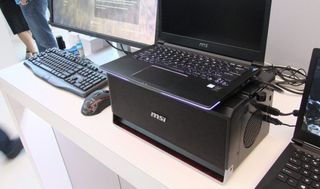MSI demonstrates their GS30 2-in-1 desktop gaming PC/laptop

Is it a bird, is it a laptop, is it a desktop? No, it's MSI's GS30...er...entertainment system? At the moment it's just a pre-production sample but the bundled laptop and dock ought to allow bona fide desktop performance via a laptop. On the road, you've got a thin and light notebook and plugged in, at home you've effectively got a full desktop running from the same system.
Sat in that chunky black dock is space for up to a 450W dual-slot desktop graphics card and on top is a x16 PCIe 3.0 connector to plug into the svelte MSI laptop with a locking mechanism to make sure it doesn't fall off. The PCIe connection itself is in the rear of the notebook, set in the hinge of the chassis.
The laptop itself is no shrinking violet either. It's a 13-inch machine, with a quad-core Haswell CPU rocking the top end of Intel's graphics line, the Iris Pro. That means it's got a certain amount of mid-range, mobile gaming performance inside if you want to frag on the go. I t's also got a seriously high-resolution 2560x1440 IPS screen.
It's not quite a seamless experience connecting up; the whole system has to be powered down when you plug it in. I'm sure something unpleasant would happen if you tried to dock right in the middle of a game.

As the GamingDock connects via a full x16 PCIe connection on the rear of the laptop itself, there shouldn't be the sort of performance degradation we've seen in previous attempts at docking desktop graphics with mobile machines. Asus tried and failed to get it's XG Station—a similar PCIe-based GPU dock—off the ground for years. But because it was using an XpressCard connection it only had a PCIe 1.1 x1, giving it a serious performance drop-off for the card it was using.
As well as offering a connection to the GPU the GamingDock also supplies charging power to the laptop, provides a built-in speaker, an extra SATA storage connection and USB ports too. Inside is space for a chunky discrete GPU as well as what looks like a SFX standard power supply.
It's the flexibility that the GS30 offers that is most exciting. "When you really want to game you probably want a big monitor, you want a real keyboard, you want a mouse," said Chris Silva, director of marketing for Intel's Premium Notebooks.
PC Gamer Newsletter
Sign up to get the best content of the week, and great gaming deals, as picked by the editors.
"I think MSI has done a really innovative job of bringing those two together. So now you've got your highly-portable device—and you can do some gaming on it—and then you dock later."
At the moment we're at a stage where most of our PC games are GPU-bound. Being able to simply swap out the discrete GPU in the dock means that when you find you simply need more performance, it's a drop-in upgrade.
The Core i7 CPU inside the GS30 laptop is still going to be capable of supplying enough data to keep any attached GPU running at pretty much top speed for years to come.
At the moment the unit I had a play with at this year's IDF is still just a pre-production sample, but it's looking set to launch at CES in January next year. It'll likely go for the same price as a full desktop, but with more flexibility.
Would you want to swap your desktop machine for this sort of laptop hybrid?

Dave has been gaming since the days of Zaxxon and Lady Bug on the Colecovision, and code books for the Commodore Vic 20 (Death Race 2000!). He built his first gaming PC at the tender age of 16, and finally finished bug-fixing the Cyrix-based system around a year later. When he dropped it out of the window. He first started writing for Official PlayStation Magazine and Xbox World many decades ago, then moved onto PC Format full-time, then PC Gamer, TechRadar, and T3 among others. Now he's back, writing about the nightmarish graphics card market, CPUs with more cores than sense, gaming laptops hotter than the sun, and SSDs more capacious than a Cybertruck.
Most Popular

